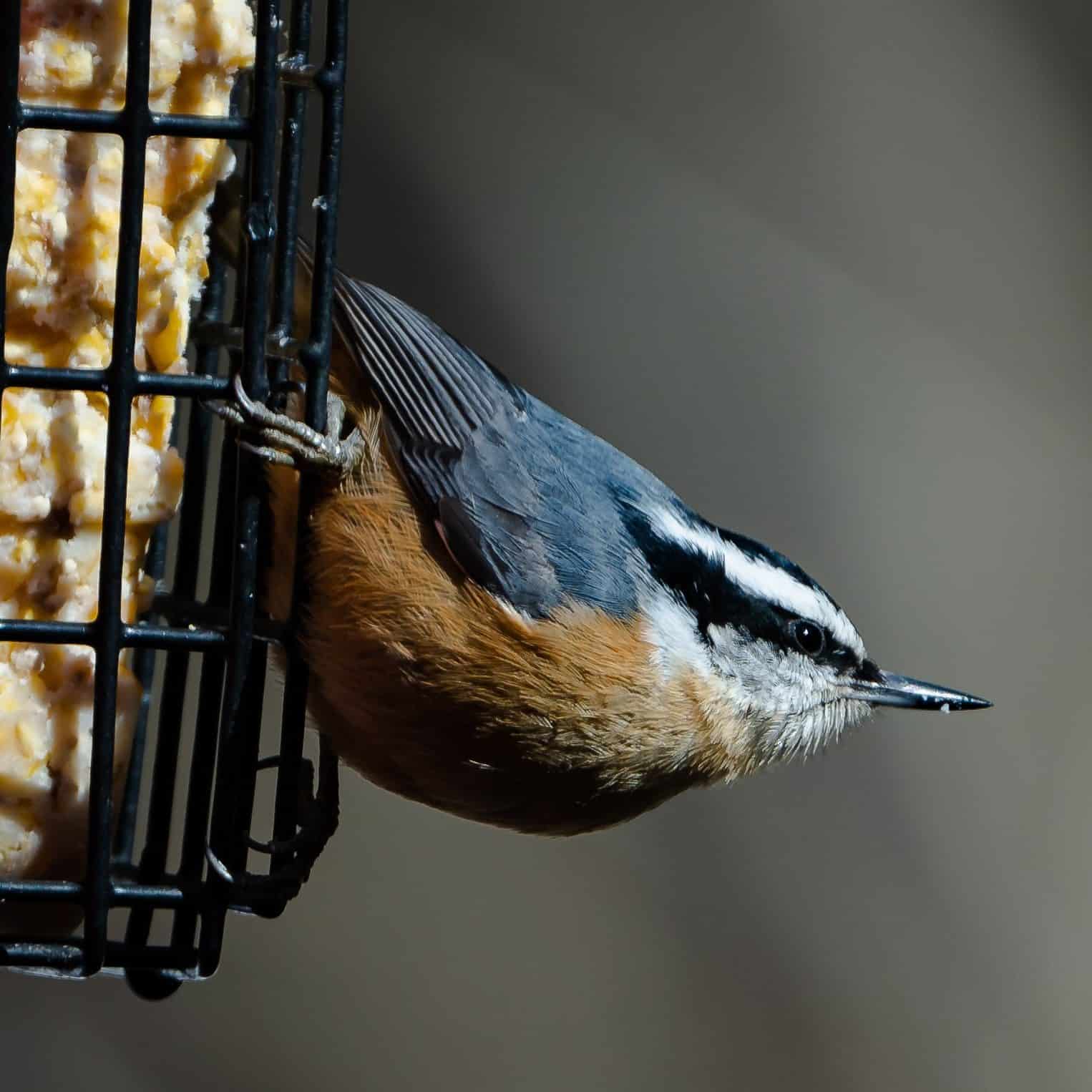Attract red-breasted nuthatches with simple actions that will render your yard irresistible to them. The first time you spot one climbing down the side of a tree headfirst, you will immediately fall in love and want more in your yard. Since this bird has a wide range throughout the US and Canada there’s a good chance you can successfully entice them.
I’ve been attracting red-breasted nuthatches for more than 20 years. The first time I saw one – I did a double-take which meant I had to know more about it. So, I hit my birding books and chatted with my fellow birding pals to create a list of simple but highly effective things you can do to attract red-breasted nuthatches to your yard.
7 ways to easily attract red-breasted nuthatches to your yard:
- Provide Food They Love
- Have Water Available
- Plant Conifers
- Go Organic
- Avoid Clearing Dead, Dying Trees
- Offer Nesting Material
- Keep Kitty Inside
Before I get into the detail I’d first like to share where they live, what they look like, their habitat, sounds, diet, mating, and nesting habits.
If you’re in a hurry feel free to skip ahead to the details.
Range: Where Red-Breasted Nuthatches Live
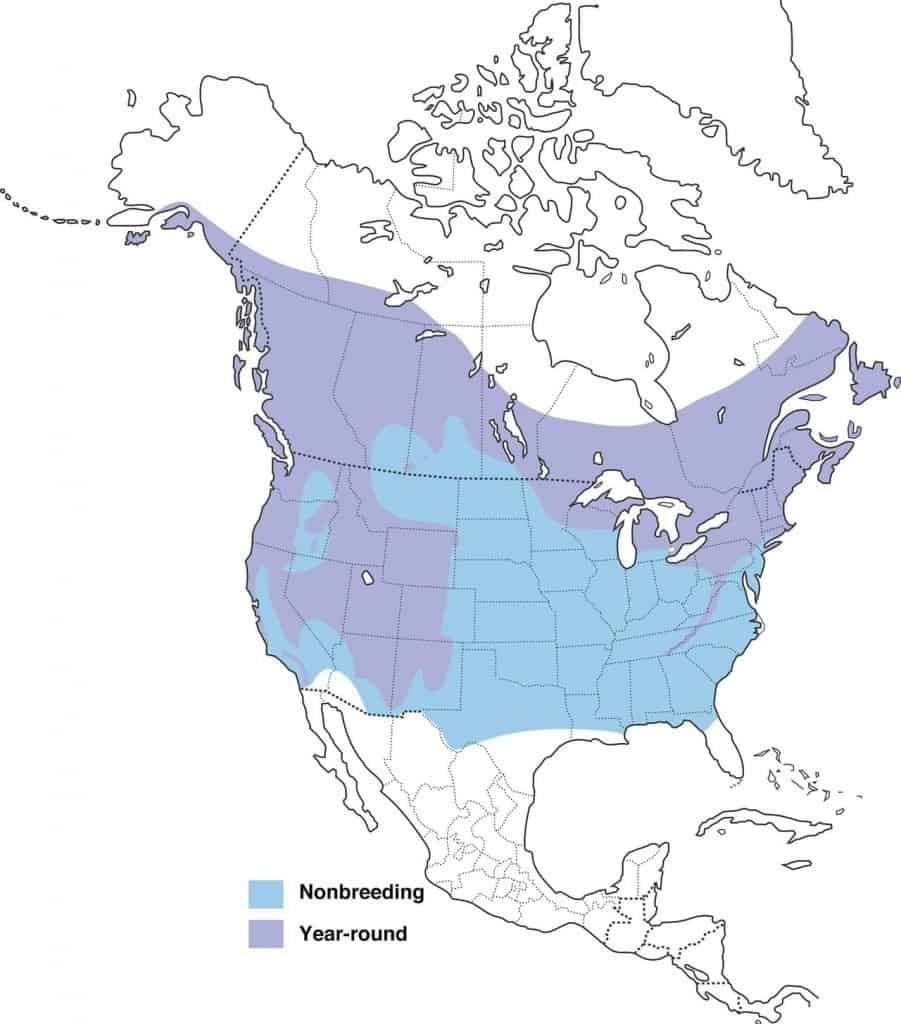
Red-breasted nuthatches are found throughout the US and much of Canada.
Many of them live year-round in the pacific northwest, southern parts of Canada, and the eastern US.
For those birds that do migrate, breeding generally takes place in northern Canada, while wintering occurs through the US central and southeastern states as well as southern California.
Their ranges don’t follow any regional boundaries so best to check out the map above.
Appearance
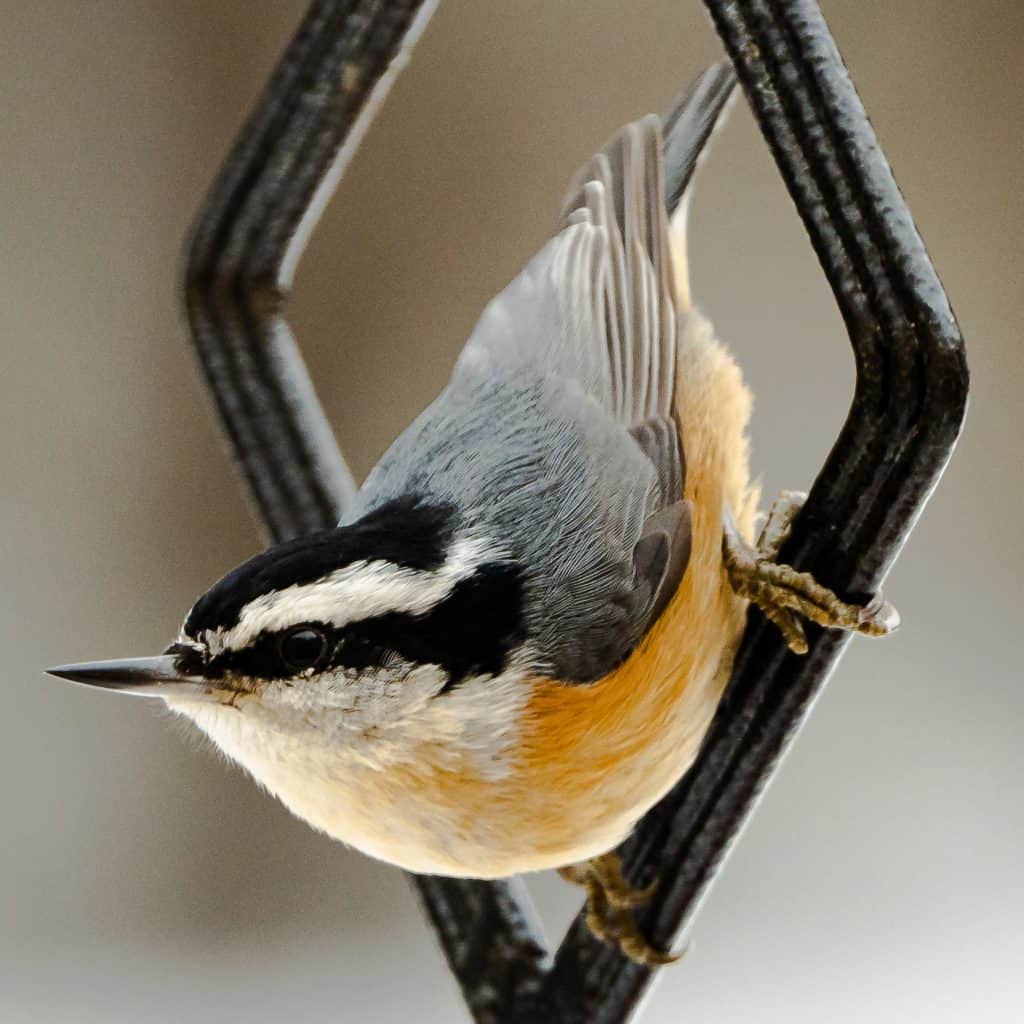
These little cuties are only 4 1/2″ long – much like the size of a chickadee. They are very easy to identify with grayish-blue backs, a white head with black stripes running over either eye, orange-cinnamon-colored breasts, short legs & tail, and a pointy pick-like beak. Females look the same except their underside is a more faded color.
Red-breasted nuthatches most closely resemble their cousins – the Pygmy nuthatch and Brown-headed Nuthatch. These two birds are also compact little guys about 4 1/2″. The beaks are similar but the coloring is a bit different.
Its cousin, the white-breasted nuthatch, has the same blue-gray upper colors, an all-white face, white breast, and about 1 1/4″ bigger than the red-breasted nuthatch but no black stripes on the face.
Habitat
This bird can be found where insects are in abundance.
Specifically, red-breasted nuthatches prefer forested areas primarily comprised of coniferous trees – pines, firs, spruces, hemlock, and red cedar.
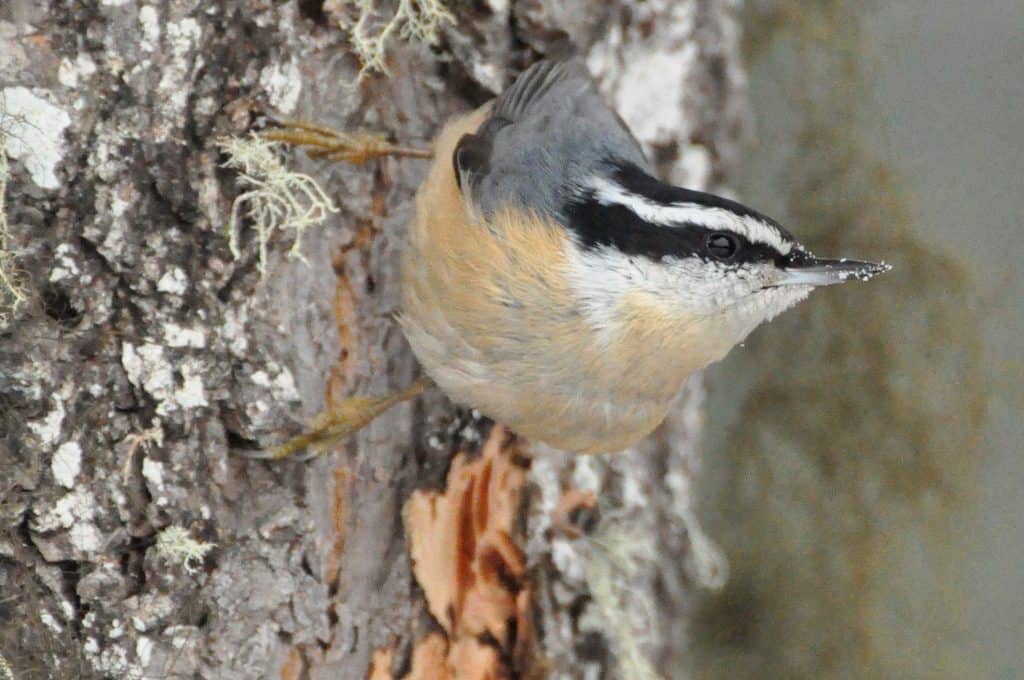
In the east, they lean more toward woodsy areas comprised of deciduous trees while southern birds prefer mountainous regions until winter comes in which case they head to lower land.
Diet & Feeding Behavior
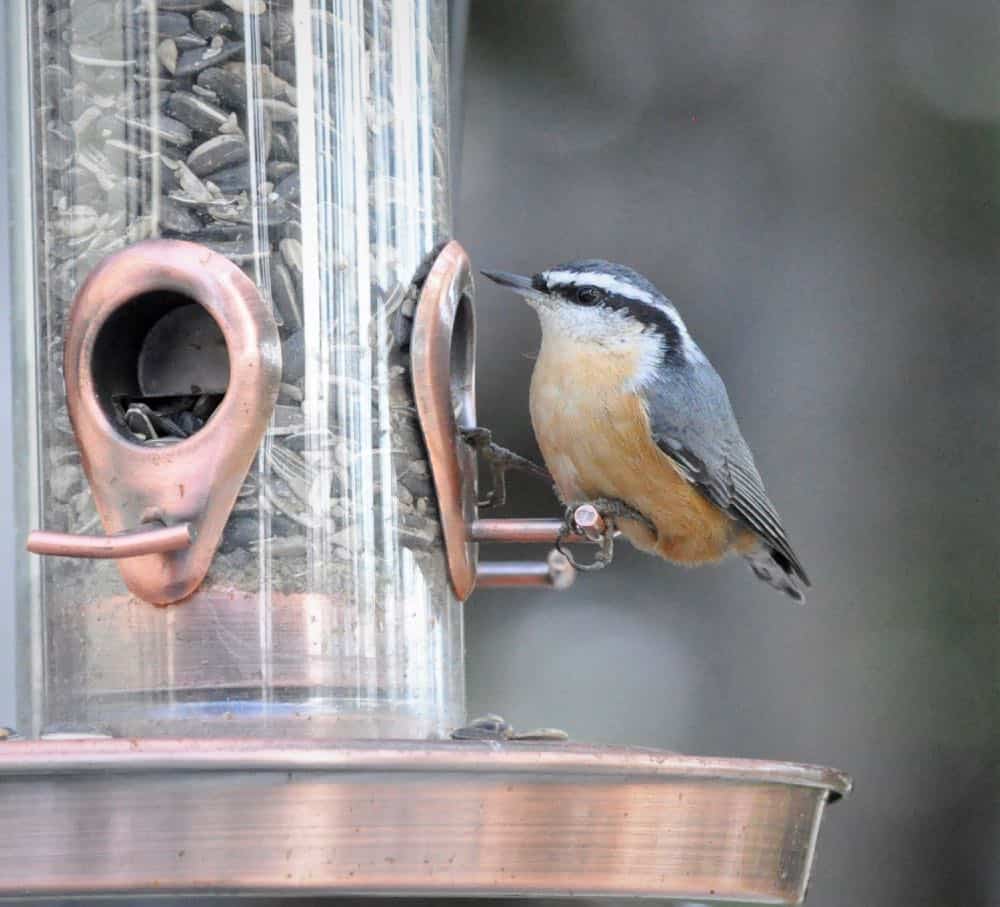
This bird’s primary summertime food is insects, spiders, and other bugs. They use their pick-like beaks to pry under the bark and coax their food out. As they make their way down the trunk of the tree, head first, they have a unique view of bugs others may have missed (like woodpeckers). It’s worth noting they also travel head-first up trees.
In the winter they commonly dine on seeds such as acorns, beechnuts, and of course birdseed. They will also partake in feeder fare. More on that later.
Like many nut eaters, nuthatches will store seeds in the cracks of bark for later – a practice called “caching”. It’s a risky venture as other animals may find the food before the nuthatch returns for it or they could totally forget where they put it! So, bonus if they remember and it hasn’t been stolen!
Sounds
Nesting, Eggs, and Fledglings
Male nuthatches will attract their mate by displaying what I can only describe as “the swivel dance”. This video shows better than I could ever describe it.
Red-breasted nuthatches are cavity nesters and are unique from other small cavity nesters in that they generally prefer to excavate their own holes. On occasion, they will use an abandoned woodpecker cavity for their nest. While both males and females work together to excavate the nest, the female will make it homey by filling it with bark strips, grass, and pine needles then lining with animal fur, feathers, moss, or fine grasses.
Another unique mannerism of this bird is they smear conifer resin (a special gummy substance) to the edges of their cavity entrance. This clever trick is thought to discourage nesting competitors and predators from paying a visit.
Each brood contains an average of 6 eggs that are white and speckled with red-brown specks. They are little eggs about .6″ x .5″.
The female incubates the eggs for 12-13 days and the fledglings are ready to leave the nest at about 18-21 days.
Red-breasted nuthatches have just one brood per season.
Predators
According to Animal Diversity, adult red-breasted nuthatches’ biggest worries include hawks, merlins, owls, red squirrels, and weasels.
The eggs and fledglings can fall prey to the typical group of nest raiders: steller’s jays, house wrens, chipmunks, weasels, and mice.
Seven Simple Ways to Attract Red-Breasted Nuthatches to Your Yard
1. Provide Food they Love
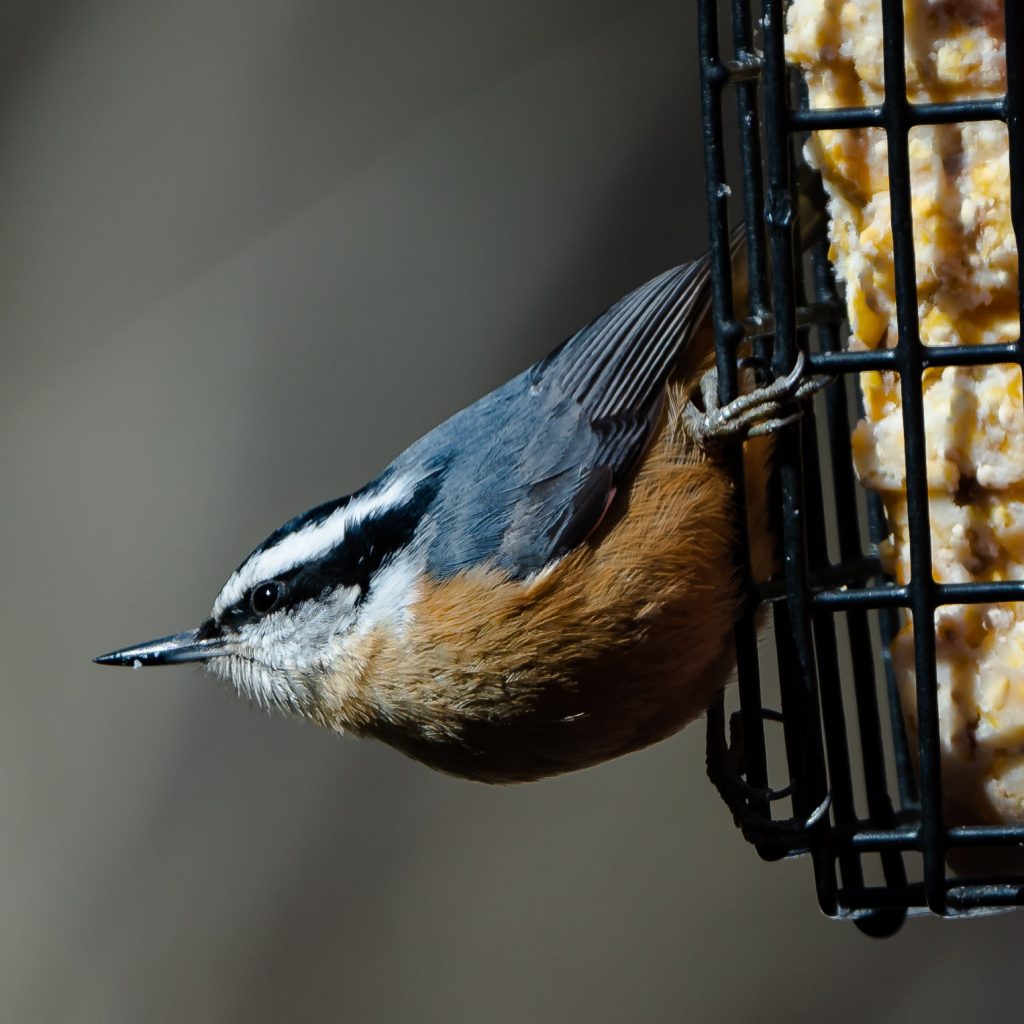
Attract red-breasted nuthatches with their favorite foods. These birds are common visitors to the feeder – but somewhat irregular. In order to entice them provide the following feeder foods, listed in the order of their preference:
- Suet
- Suet spread/peanut butter
- Sunflower seeds
- Shelled peanuts
- Fruit
To get better results, hang the feeders from a tree limb instead of an open area.
Also, don’t be offended if they take a treat and fly off to enjoy it – this is typically what they do. They’ll take the tasty treat and wedge it into a crack then hammer it into bitesize pieces with their pointy beak.
Although not as common as the above feeder fare, these birds will also dine on fruit.
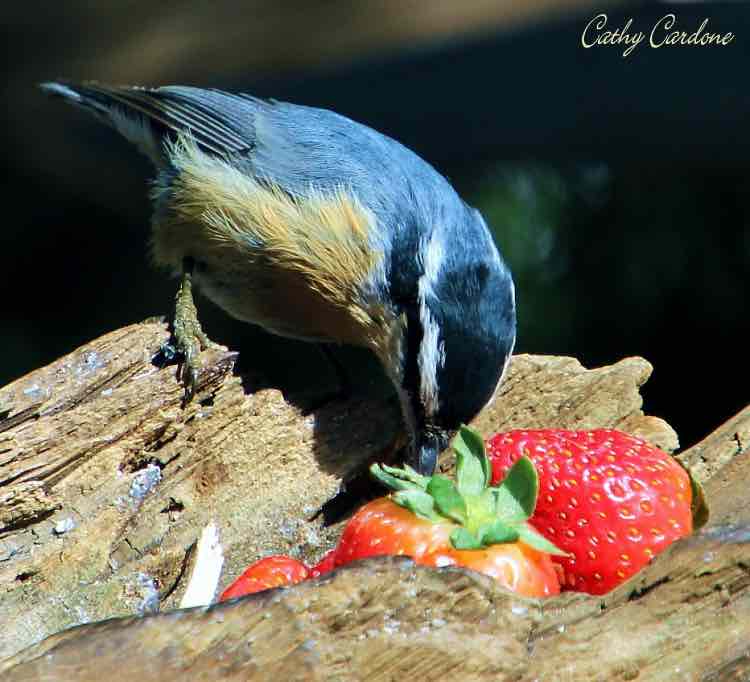
2. Have Water Available
All birds need water to drink and bathe in. Red-breasted nuthatches are no different. If a natural source of water is not available nearby consider installing a pond – even a small patio pond will attract all wild birds.
A birdbath is another viable option. Birds are drawn to moving water so adding a fountain to the birdbath could increase your chances of attracting one. Red-breasted nuthatches are small birds so make sure the birdbath does not exceed 1/2 in-depth or add layers of flat rocks as an alternative.
In the winter consider adding a much-appreciated “heated” birdbath. Frozen water doesn’t do them much good.
3. Plant Conifers
Attract red-breasted nuthatches by planting conifer trees. These trees are a key part of their habitat. They live amongst and nest in firs, spruces, and pine trees (among other conifer-type trees) and seek food near them as well. As mentioned earlier, they like to spread conifer resin (a sticky substance produced by these trees) around their nesting cavity to deter predators and competitor birds.
By providing a close match to their natural habitat you increase your chances of having them visit your yard.
4. Go Organic
Avoid using chemicals in and around your yards such as grass fertilizer and pesticides. Red-breasted nuthatches, and other wild birds, consume insects as their primary source of food and if you kill them off, there won’t be any to eat.
Equally horrible would be death by poisoning in the case of a wild bird eating a toxic insect!
5. Avoid Clearing Dead, Dying Trees
Attract red-breasted nuthatches by leaving your dead and dying standing trees. They excavate a nesting cavity in the dead trees. If you’re serious about luring them in your yard, resist the urge to knock down and haul away these trees.
6. Offer Nesting Material
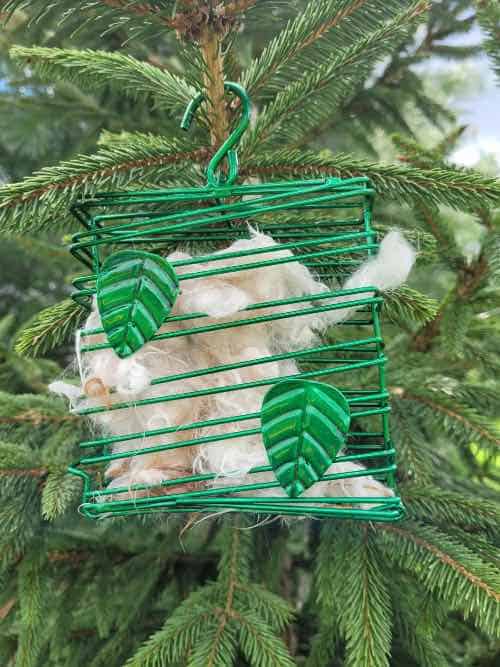
Attract red-breasted nuthatches by providing nesting materials. This enables them to spend more energy on building the nest rather than seeking out the ideal materials.
Pet fur is ideal as well as short pieces of string remnants. Trying to put them in an empty suet cage and hanging out for them to find.
Caution: Never provide human hair as birds can get tangled in it.
7. Keep Kitty Inside

A primary predator to birds everywhere are cats. This is especially true for ground foragers like red-breasted nuthatches. Not only are house cats dangerous, but also the feral cats that can roam a neighborhood.
According to a study published in Nature Communications, each year almost 4 billion wild birds lose their lives to outdoor cats. Not only does this rock the ecology it makes your yard unappealing and dangerous for many forms of wildlife.
If it’s your cat, keep it inside. Don’t be fooled. Even the nicest and sweetest of kitties have the natural instinct to hunt birds. It’s not their fault.
If it’s a feral cat implement a non-toxic deterrent method such as scattered fresh orange or lemon peels in the area.
If you’re really gung ho, consider trapping the feral feline and taking it to a human society that offers free neutering/spaying. This may prevent the next person from having to deal with a feral cat at their feeder.
Next Steps
I think you’ll agree the red-breasted nuthatch is worth enticing to your yard. Take and apply some of the tips I provided or if you’re really serious about attracting them to your yard – apply all of them! Good luck and happy birding!

